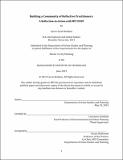| dc.contributor.advisor | Lawrence Susskind. | en_US |
| dc.contributor.author | Watkins, Carrie Sarah. | en_US |
| dc.contributor.other | Massachusetts Institute of Technology. Department of Urban Studies and Planning. | en_US |
| dc.date.accessioned | 2020-02-28T20:50:57Z | |
| dc.date.available | 2020-02-28T20:50:57Z | |
| dc.date.copyright | 2019 | en_US |
| dc.date.issued | 2019 | en_US |
| dc.identifier.uri | https://hdl.handle.net/1721.1/123917 | |
| dc.description | This electronic version was submitted by the student author. The certified thesis is available in the Institute Archives and Special Collections. | en_US |
| dc.description | Thesis: M.C.P., Massachusetts Institute of Technology, Department of Urban Studies and Planning, 2019 | en_US |
| dc.description | Cataloged from student-submitted PDF version of thesis. | en_US |
| dc.description | Includes bibliographical references (pages 84-85). | en_US |
| dc.description.abstract | In 1983, Massachusetts Institute of Technology (MIT) Professor Donald Schön published The Reflective Practitioner. In this book, he challenged the prevailing view of professional practice, which he understood as linked to the positivist practice of technical rationality. He called on educational institutions to instead train professionals such as planners, architects, and teachers to be reflective practitioners -- to practice reflection-in and on-action. In this thesis, I set out to explore the curious tensions and patterns that shape MIT Department of Urban Studies and Planning's relationship with reflective practice. This thesis is my reflection-in-action, the pursuit of knowledge through active interventions and observations. I worked with Professor Ceasar McDowell this Spring of 2019 to facilitate reflective sessions for practicum classes, and through observation, surveys, and interviews, I studied the reflections' effects on class learning and effectiveness and on how students and faculty value and understand reflection. As an international leader, my home institution, and the locus of Schön's work, MIT offers an excellent case example to study. I ultimately found that, while successful and innovative reflective practices can be found throughout DUSP, a large gap exists between the high value of reflective practice faculty and students espouse and the efforts individuals and the department as a whole actually take to train and incorporate reflective practice. This process also uncovered insights that I wove into a set of recommendations for students, faculty, and the department to help close this gap between espoused theory and theory-in-use. While my findings and analyses are specific to this location, I hope they will inform and provide energy to the broader conversation in support of reflective practice. | en_US |
| dc.description.statementofresponsibility | by Carrie Sarah Watkins. | en_US |
| dc.format.extent | 86 pages | en_US |
| dc.language.iso | eng | en_US |
| dc.publisher | Massachusetts Institute of Technology | en_US |
| dc.rights | MIT theses are protected by copyright. They may be viewed, downloaded, or printed from this source but further reproduction or distribution in any format is prohibited without written permission. | en_US |
| dc.rights.uri | http://dspace.mit.edu/handle/1721.1/7582 | en_US |
| dc.subject | Urban Studies and Planning. | en_US |
| dc.title | Building a community of reflective practitioners : a reflection-in-action with MIT DUSP | en_US |
| dc.title.alternative | Reflection-in-action with Massachusetts Institute of Technology, Department of Urban Studies and Planning | en_US |
| dc.type | Thesis | en_US |
| dc.description.degree | M.C.P. | en_US |
| dc.contributor.department | Massachusetts Institute of Technology. Department of Urban Studies and Planning | en_US |
| dc.identifier.oclc | 1140071470 | en_US |
| dc.description.collection | M.C.P. Massachusetts Institute of Technology, Department of Urban Studies and Planning | en_US |
| dspace.imported | 2020-02-28T20:50:57Z | en_US |
| mit.thesis.degree | Master | en_US |
| mit.thesis.department | UrbStud | en_US |
